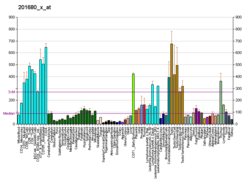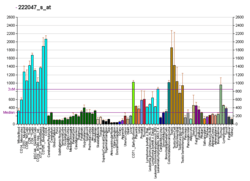Serrate RNA effector molecule homolog
Serrate RNA effector molecule homolog (SRRT) also known as arsenite-resistance protein 2 (ARS2) is a protein that in humans is encoded by the SRRT gene.[5]
The SRRT gene product plays a role in RNA-mediated gene silencing (RNAi) by miRNAs. Independently of its activity on miRNAs, it is necessary and sufficient to promote neural stem cell self-renewal, by directly binding the SOX2 promoter and positively regulating its transcription.
It does not directly confer arsenite resistance but rather modulates arsenic sensitivity. Diseases associated with SRRT include spondylocostal dysostosis.
References
- GRCh38: Ensembl release 89: ENSG00000087087 - Ensembl, May 2017
- GRCm38: Ensembl release 89: ENSMUSG00000037364 - Ensembl, May 2017
- "Human PubMed Reference:". National Center for Biotechnology Information, U.S. National Library of Medicine.
- "Mouse PubMed Reference:". National Center for Biotechnology Information, U.S. National Library of Medicine.
- "Entrez Gene: ARS2 ARS2 protein".
Further reading
- Rossman TG, Wang Z (1999). "Expression cloning for arsenite-resistance resulted in isolation of tumor-suppressor fau cDNA: possible involvement of the ubiquitin system in arsenic carcinogenesis". Carcinogenesis. 20 (2): 311–6. doi:10.1093/carcin/20.2.311. PMID 10069470.
- Wilson MD, Riemer C, Martindale DW, et al. (2001). "Comparative analysis of the gene-dense ACHE/TFR2 region on human chromosome 7q22 with the orthologous region on mouse chromosome 5". Nucleic Acids Res. 29 (6): 1352–65. doi:10.1093/nar/29.6.1352. PMC 29746. PMID 11239002.
- Scherer SW, Cheung J, MacDonald JR, et al. (2003). "Human chromosome 7: DNA sequence and biology". Science. 300 (5620): 767–72. doi:10.1126/science.1083423. PMC 2882961. PMID 12690205.
- Di Y, Li J, Zhang Y, et al. (2004). "HCC-associated protein HCAP1, a variant of GEMIN4, interacts with zinc-finger proteins". J. Biochem. 133 (6): 713–8. doi:10.1093/jb/mvg091. PMID 12869526.
- Obuse C, Yang H, Nozaki N, et al. (2004). "Proteomics analysis of the centromere complex from HeLa interphase cells: UV-damaged DNA binding protein 1 (DDB-1) is a component of the CEN-complex, while BMI-1 is transiently co-localized with the centromeric region in interphase". Genes Cells. 9 (2): 105–20. doi:10.1111/j.1365-2443.2004.00705.x. PMID 15009096.
- Beausoleil SA, Jedrychowski M, Schwartz D, et al. (2004). "Large-scale characterization of HeLa cell nuclear phosphoproteins". Proc. Natl. Acad. Sci. U.S.A. 101 (33): 12130–5. doi:10.1073/pnas.0404720101. PMC 514446. PMID 15302935.
- Ballif BA, Villén J, Beausoleil SA, et al. (2005). "Phosphoproteomic analysis of the developing mouse brain". Mol. Cell. Proteomics. 3 (11): 1093–101. doi:10.1074/mcp.M400085-MCP200. PMID 15345747.
- Beausoleil SA, Villén J, Gerber SA, et al. (2006). "A probability-based approach for high-throughput protein phosphorylation analysis and site localization". Nat. Biotechnol. 24 (10): 1285–92. doi:10.1038/nbt1240. PMID 16964243.
- Szafranski K, Schindler S, Taudien S, et al. (2007). "Violating the splicing rules: TG dinucleotides function as alternative 3' splice sites in U2-dependent introns". Genome Biology. 8 (8): R154. doi:10.1186/gb-2007-8-8-r154. PMC 2374985. PMID 17672918.
This article is issued from Wikipedia. The text is licensed under Creative Commons - Attribution - Sharealike. Additional terms may apply for the media files.






